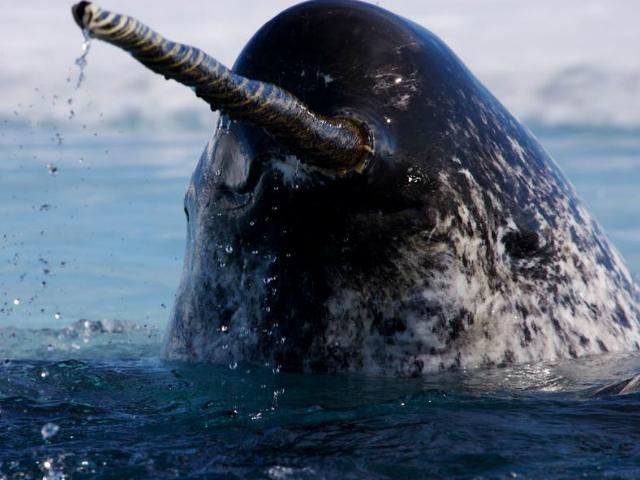Drone camera unlocks secrets of narwhal tusks
The narwhal is quite the bizarre creature. One look at the whale is enough for the child within us to envision epic undersea swordfights, and battles that end with adversaries such as giant squid impaled upon its mighty unicorn horn.
Well, we can thank science for killing such childish fantasies! Recent drone footage has revealed that the narwhal uses its “horn” to hit and stun prey, not to kill ‘em dead with slick hack-and-slash moves.
To be specific, wild narwhals use their tusks to give the Arctic cod quick, hard taps. This renders the fish immobile, and therefore easier to catch.
The behavior was captured by a pair of drones in far northeastern Canada’s Tremblay Sound, Nunavat. Operating the drones were Adam Ravetch of the World Wildlife Fund (WWF) Canada, and Fisheries and Oceans Canada researchers.
Brandon Laforest, a WWF Canada senior specialist of Arctic species and ecosystems, explained what makes narwhals unique among whales.
“They don’t jump like other whales. They are also notoriously skittish,” he stated.
As for the narwhal using its tusk to hit and stun fish, Laforest said: “This is an entirely new observation of how the tusk is used.”
The tusk is, in fact, a left canine tooth that evolved to be extremely long (it can grow up to 9 feet or 2.7 meters in length). This tooth pierces through the creature’s upper lip to poke out from its noggin, all majestic-like. Which is why this tusk, or horn, is responsible for the narwhal’s colloquial designation: the unicorn of the sea.
The purpose of the tusk has eluded scientists for quite a while. In the absence of concrete evidence, a number of theories have cropped up about its function, including its use in territorial disputes, navigation, and the breaking of sea ice. It’s even been imagined as a predictor of testicle size in the whale version of “you know what they say about men with big feet.”
But those tusks look awfully weapon-like. This recent video footage proves that the tusks are indeed used as weapons… only they’re more like clubs than swords.

More than a weapon
But the tusk is more than a weapon. Last year, research revealed that this multipurpose tool also helps the narwhal navigate the murky depths by enhancing the whale’s natural echolocation ability.
Whales and dolphins produce around a thousand clicks per second. The sound waves produced by these clicks bounce off objects or living things in the animals’ surroundings, allowing them to construct a detailed “picture” of their environment.
In the evolution of the narwhal tusk, however, the specialized tooth lost its protective enamel layer. This means the tusk is extra-sensitive to stimuli, which in turn makes narwhals better at echolocation than other whale species.
So how does this extra sensitivity work? Researchers suspect seawater enters the tiny pores found in the tusk’s tip. Bubbles then proceed up the shaft all the way to the tusk’s base close to the narwhal’s skull. The thousands of nerve endings found here are stimulated by said bubbles, leading to the transmission of signals to the creature’s brain informing it of the nature of its immediate environment.
“They can feel their surroundings similar to how a human’s broken tooth would have feeling,” said research scientist Marianne Marcoux of Fisheries and Oceans Canada.
This extra sensitivity might explain why the narwhals in the above videos seem hesitant to use their tusks in an extremely violent manner.
This also means that territorial battles between narwhals can prove quite costly. Maybe each fight hurts a little more than your average tooth ache.
Save the narwhals!
90 percent of the narwhals on the planet make Canadian waters their home. These creatures and their habitats have suffered due to industrial development. For instance, narwhals are more likely to be hit by ships in areas used for tourism and mineral extraction. These ships also cause underwater noise pollution, which interferes with their communication abilities.
For these reasons, Laforest believes it is important to develop shipping routes that avoid areas populated by the narwhals.
It is also worth mentioning that climate change may be having a detrimental effect on the species. The narwhal diet consists of animals that depend on sea ice for survival. Warming waters and the melting of sea ice are therefore problems that could impact narwhals. — TJD, GMA News




